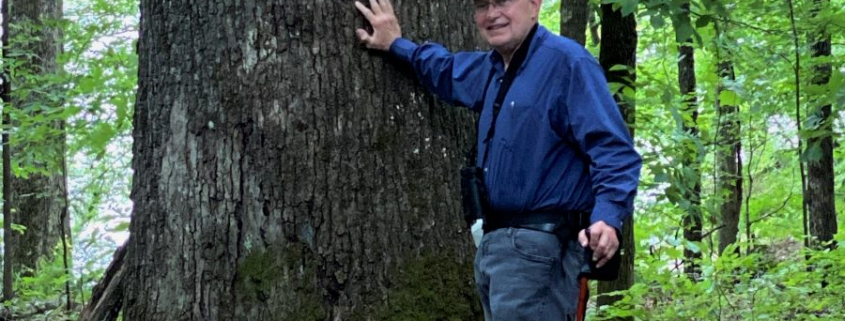Joe Wheeler State Park’s New “Awesome Trail”
Allow me to set the stage for this Post with a simple quote from Wendell Berry:
Outdoors we are confronted everywhere with wonders; we see that the miraculous is not extraordinary, but the common mode of existence. It is our daily bread.
The Alabama State Parks Dirt Pass Trail Crew completed the eight-mile Awesome Trail spring of 2020. I hiked the four lakeside miles June 8. Rain prevented covering the return leg that runs more interior from the water’s edge. The trail moniker fits, yet keep in mind that I am easily persuaded and seduced by things Nature. I seldom meet a path through wildness that I deem routine, ordinary, and uninspiring. This new trail did not flirt with dull… rising to truly awesome for those who read the landscape, appreciate subtleties, and look deeply enough to see the wonder lying in plain sight. So, join me as I introduce the physical trail, reveal evidence of past human land use, highlight some special trees and tree anomalies, and give you a glimpse of animal friends we encountered. I urge you to watch for a subsequent Blog Post reviewing the spectacular array of fungal inhabitants presenting their own aesthetic magic along the trail.
The Magnificent Awesome Trail
I offer a photograph of the recently printed map in lieu of what I am confident will, in due time, be handsome trailhead signage.
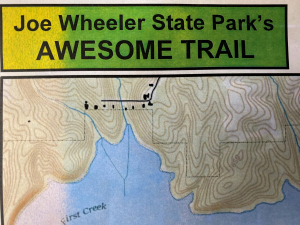
We parked Alabama State Parks Emeritus Naturalist Mike Ezell’s vehicle at at the Park’s boat ramp, four miles from the Marina and Lodge, where my car awaited us. The boat ramp end of the Awesome Trail begins at the Jimmy Sims Birding Trail. The small wood-routered “Marina 4 Miles” sign with anchor is new, itself an implied welcome to the Awesome Trail.
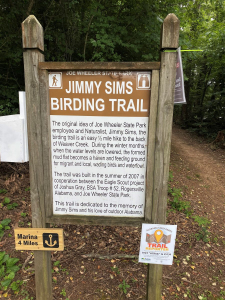
The milepost signs along our route hint at the quality we will in time see at the trailheads. I add these photos in part to evidence that we did indeed traverse the distance… a leisurely stroll through diverse forest, reading the topography, land use history, and delightful stories of clearing, erosion, healing, and the passage of time.
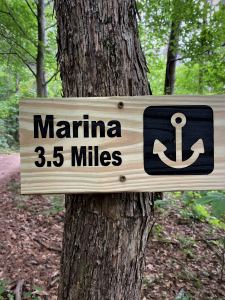
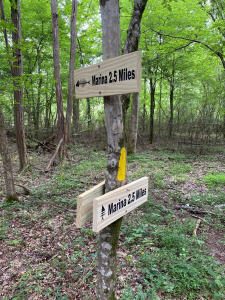
I had visited Joe Wheeler this past July 10 (https://stevejonesgbh.com/2019/08/09/july-return-to-joe-wheeler-state-park/), seeing the Alabama State Parks Dirt Pass Trail Crew in action (below). The Crew is superb, led by Ken Thomas, State Parks Trails Coordinator, who never met a trail challenge he doesn’t embrace and resolve.
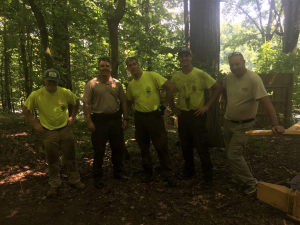
Our July visit revealed just one of the many “opportunities” facing the crew… a too-wet drain capturing this piece of heavy trail construction equipment. We watched a Park tractor come to the rescue, extracting the bogged tracked vehicle. You’ll see an example below the stuck machine of the beautifully-engineered wooden bridges the Crew installed to go over the drainage-ways crossing the trail to reach Joe Wheeler Lake.
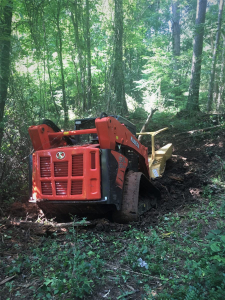
There’s something about the feel and aesthetic of a well-designed wooden bridge or walkway that amplifies my appreciation of Nature. Note the steel cables securing the bridge at its near, upstream end (below left). The placid water (below right) belies the torrents that winter and spring rains generate.
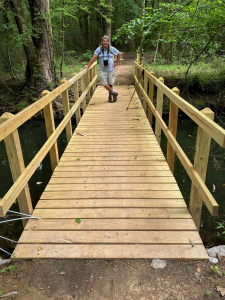
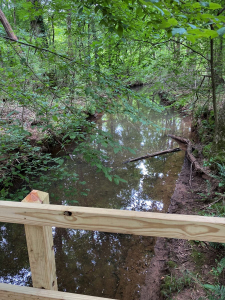
The trail occasionally drops very close to the Wheeler Lake high water elevation of 555-feet. We embraced the cloud cover and below-average high temperature for the date. North Alabama summers can dissuade vigorous mid-day hiking, especially for a couple of geezers!
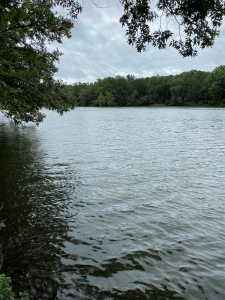
Mike reminded me several times that Joe Wheeler State Park soils are limestone-derived. Here we found direct evidence at the surface.
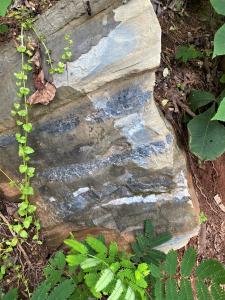
The new trail is wide, well-graded, and generally easy to trek at whatever pace one chooses. Below left finds me posing in a copse of yellow poplar (Liriodendron tulipifera) at an intersection with a trail departing to the left. That’s Mike below right back-dropped by the gentle path fading toward the marina.
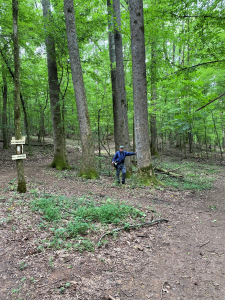
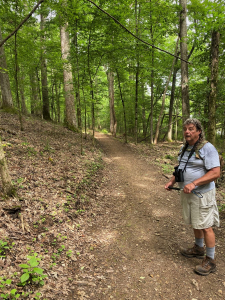
Although the trail passed through 80-90 year-old deep forest, we found evidence that the forest condition followed prior intensive land use. Below left the trail crosses an old embedded road at right angles. Imagine what is now Lake Wheeler as gentle tributary streams and the Tennessee River flowing through wide fertile bottoms, transected by roads, and occupied by homes and farming communities. Thousands of people populated the 69,000 acres (104.6 square miles) inundated by Wheeler Dam. The now abandoned transecting road entered the rich bottomland at waterline just below the trail. Who knows what commerce its traffic of trucks and wagons performed. Within a hundred feet of where it crossed Mike stands among debris (several old barrel hoops, some rusted drums, and other hardware and stones) we think may have been associated with a still. Ah, yet another agriculture-based form of commerce!
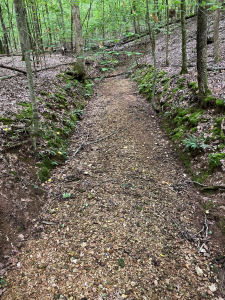
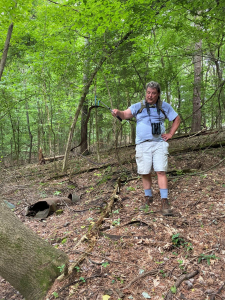
The forest we traversed helped to heel the scars of abusive agriculture from a time when agriculture pushed and exceeded the limits of land clearing and over-grazing. Deep gullies washed precious topsoil from fragile hillsides to the Tennessee River, and from there into the Ohio to the Mississippi to the Gulf of Mexico. What Nature took eons to build, careless agriculture loosed to the sea in a mater of one or two generations. Nature is resilient, yet even she will require centuries or millennia to fully heal.
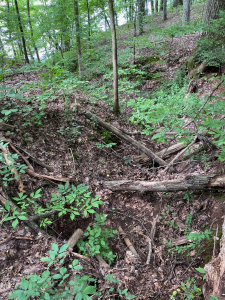
Clouds thickened as we drew within the final mile of the marina. In fact, a hard shower caught us before we reached my vehicle.
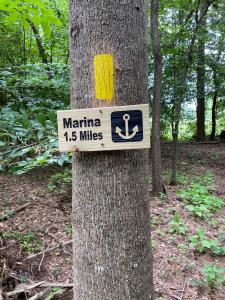
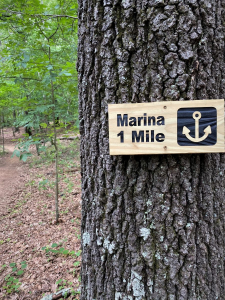
Special Trees and Tree Anomalies
I seldom enter forested wildness without seeing and photographing worthy sylvan subjects. I’m standing at a 45-inch diameter (measured at the standard 4.5-feet above ground-line) southern red oak (Quercus falcata) below left. The 30-inch yellow poplar (Liriodendron tulipifera) drew my attention both with its dimension and its notably mossy feet.
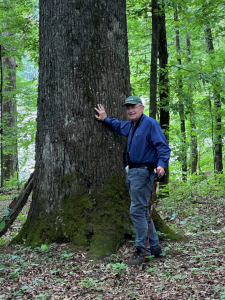
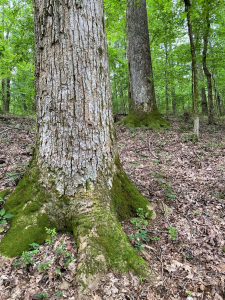
I’m reminded of Simon and Garfunkel’s America:
Laughing on the bus, playing games with the faces
She said the man in the gabardine suit was a spy
I said, be careful, his bowtie is really a camera
I suppose that I’m performing the tree equivalent of playing games with the faces. Each tree has a story to tell… and I focus on the richest tales, a full library of which we met along the trail. I took the two images below along what appeared to be another old erosion-embedded road crossing the trail at right angles. The two trees, American beech (Fagus grandifolia) below left and sweetgum (Liquidambar styraciflua), had perched for many years on the embankment rim along the road. The beech still clings in position, grasping laterally and into the undisturbed forest floor. At some point following road abandonment, the sweetgum sagged 30 degrees into the road, retaining enough anchorage to remain viable and apparently yet thriving. Both tell a tale of persistence. I estimate that both trees are well over a hundred years old, having seeded and secured life long before the forest on either side of the road sprouted from the adjoining pasture or fallowed field.
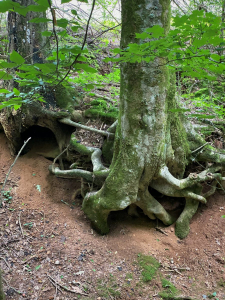
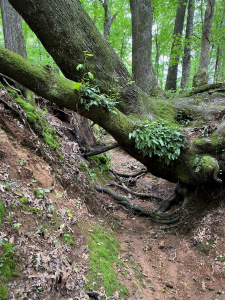
Theodor Seuss Geisell (aka Dr. Seuss) could likewise weave compelling verse around these sentinels and the magical creatures living among their roots and toppled mass. Perhaps each offers a gateway to Tolkien’s Underworld… or to Alice’s Wonderland. Were Mike not awaiting my return to the trail to continue our hike, I might have sat quietly to see who or what would peek from the mysterious portals!
There is no naturalist among us who has not been cautioned about lightning and tress. The new admonishment is, “When thunder roars, stay indoors.” The advice is easy to heed when an approaching storm disturbs a patio gathering, but what would we have done that day if one of the showers that dampened our final half-mile push to the marina had sent bolts of static in our direction? Below are a white oak (Quercus alba, left) and an American beech that decades ago could not scurry under roof. Each bears nearly full-height scars of the searing heat of a direct hit. Neither suffered mortal injuries. Tree-dwelling critters today give thanks for the homes provided. Funny how variable lightning is with respect to tree damage. I recall seeing a 100-foot tall and two-feet in diameter white ash (Fraxinus americana) struck the day before I strolled near it. I found the ash completely shattered, long wood shards and slivers thrown 50-100 feet in all directions. Yet the oak and beech below retain life and vitality many years after their unfortunate encounter.
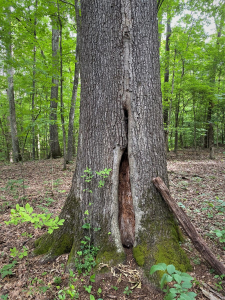
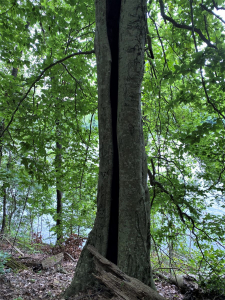
We found this red oak (below) still very much alive, leaning 15 degrees away from us, supported in part by the crowns of neighbors. What loosened its hold to the ground? As it is for all things in Nature, explanation awaits discovery. The apparent bowl and gnarly base facing the camera hint that the tree once had a twin stem that for some reason died or broke away leaving the old wound-scar. The seam running vertically on the live bole is seeping, indicating rot within, which likely advanced from the dead twin. The view under the leaning trunk evidences that on this side of the tree base, roots have decayed, leaving little anchorage. Were it not for supporting neighbors this individual would be prostrate, sprouting mushrooms and making way for new life. So much in the forest (and for our own lives as well) is a matter of chance… and, some may suggest, divine providence.
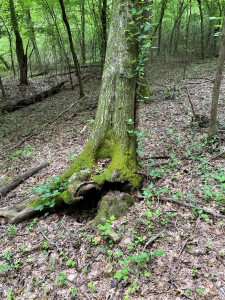
Here’s an eastern red cedar (Juniperous virginiana) that long since found a horizontal position. The forest along our route had many more dead cedar than living. This species is a pioneer, describing its propensity to occupy abandoned agricultural (tilled and pastured) land. Birds consume its waxy fruit. Avian digestive fluids secure nourishment from the fruit and merely stratify (chemically weaken the seed coat without damaging the seed within) the seed. The foraging birds, in time, drop the seed from developing herbs and forbs sprouting in the fallow fields. Like the early Europeans pioneering west of the Appalachians, cedar advances into areas where the more persistent and longer-lived pines and hardwoods will follow. This cedar captured my attention with its old skeleton lying pitifully at the hole where its decayed and now absent trunk once stood. Nature’s library contains volumes. Most people walking through the woods will never know that the tales exist. I admit to being nearly consumed by the countless stories at my feet and above my head.
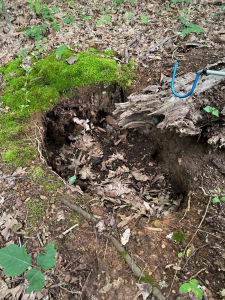
This red cedar persists, adding an element of character and mystery. I’m certain this senior citizen could reflect on those early years when it fought fiercely with brambles for soil moisture and nutrients, even as it struggled to find sunlight beyond the reach of competitors. Pioneering life is tough, yet this one persevered and remains 80-90 years beyond its valiant efforts to pave the way for the forest where it resides so comfortably.
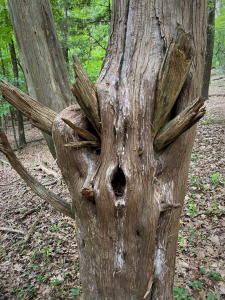
Yet even the forest that succeeded those pioneers deals with adversity… one individual at a time. Lightning is just one of many agents of death and destruction. Adversity can come in form of a companion supplejack vine (Berchemia scandens), as this shagbark hickory (Carya ovata) so painfully discovered (below left). The troubled white oak (below right) can only dream of its glory days before the forces of life and adversity dealt it a hand of heart rot and destined it to playing house and home for critters of all ilk. Easy for me in my forest products industry forester days to cast aspersions on all but the straight and fat defect-free trees of select hardwood species with high commercial value. I would have viewed both these individuals as culls, needlessly taking up space and consuming valuable site resources. Yes, I still sense a certain gleam in my eye when I see a tall veneer quality oak, but I delight in these special trees and tree anomalies. I no longer derive remuneration based upon board footage and timber grade.
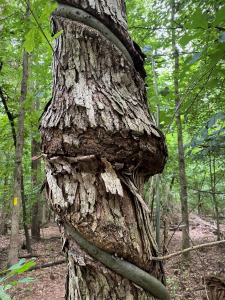
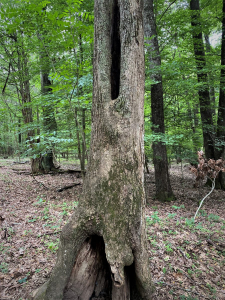
Mike is pointing to another of those timber value defects on a 30-plus-inch white oak. Neither of us viewed it as a defect. Instead, we saw a squirrel-maintained portal to the tree’s hollow interior. The tree and squirrel are at a stalemate. The tree attempts year after year to callous over the opening; the squirrel is intent upon keeping ingress and egress available. For how many millennia have squirrels and oaks done battle? So good that Nature is content with a permanent stalemate between players producing acorns and critters consuming them.
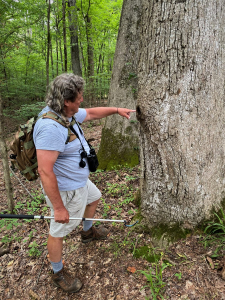
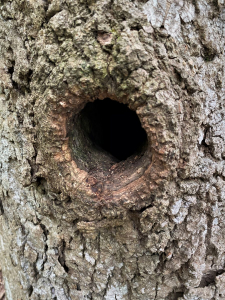
Both oaks and squirrels win across the vast sweep of time. The tree provides shelter and acorns. Squirrels disperse and plant far more acorns than they will ever collect and consume. Its a settlement meant for the ages… a reciprocal draw.
Reptiles, Mammals, and Insects
Just fifty feet from the lake, we found a map turtle (Deirochelyine turtle; Graptemys geographica), an aquatic resident probably seeking a place to deposit eggs. I will never lose my fascination with and appreciation for turtles. Talk about Covid-19 social distancing and sheltering in place!
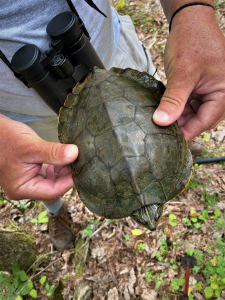
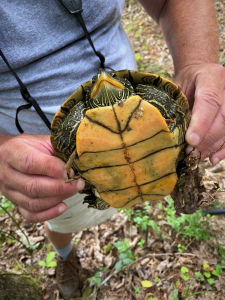
An ambitious beaver gnawed on a too-large yellow poplar lakeside. We saw lots of beaver chews whenever we neared the water.
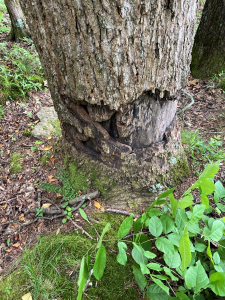
We believe that mamma had just that morning dropped her fawn. I could have touched this little guy. Instead I gently persuaded him to join his mother within sight fifty feet away.

Jeepers, creepers, where’d ya get those peepers! We found this eastern eyed click beetle (Alaus oculatus). I suppose that a hungry bird may have second thoughts before chomping down on an animal with such big eyes!
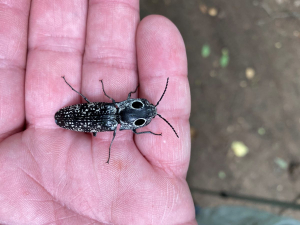
Mike and I are now set, weather permitting, to spend another day at Joe Wheeler State Park July 7. As I place the finishing touches on the Post, that’s tomorrow! Mike assures me that more beauty, magic, wonder, and awe await us.
The Awesome Power of Nature’s Fury
December 19, 2019 a late fall squall dropped a twister into the park, destroying the campground and this restroom facility. Trees across a wide swath jack-strawed. Fortunately, no visitors were in the path. We shudder to think what would have been the loss of life and limb had the twister appeared during a packed summer weekend. Nature is always in control. Her power is almost sometimes beyond comprehension. A terror to behold.
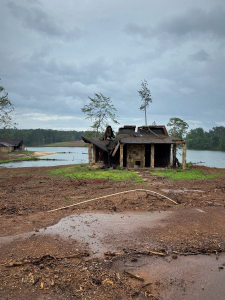
The old saw offers tremendous insight and wisdom: Don’t mess with Mother Nature. We should heed that advice. Unless we societally accept and practice informed and responsible Earth stewardship, our species is doomed. We will reach thresholds beyond which Nature will not forgive. Importantly, she will persist. It is we who will suffer the consequences of irreparable harm.
Thoughts and Reflections
I borrow a simple quote from Wendell Berry relevant to our trek along the Awesome Trail:
Outdoors we are confronted everywhere with wonders; we see that the miraculous is not extraordinary, but the common mode of existence. It is our daily bread.
Inhale and absorb Nature’s elixir. May Nature Inspire, Inform, and Reward you!
Note: All blog post images created & photographed by Stephen B. Jones unless otherwise noted. Please circulate images with photo credit: “©2020 Steve Jones, Great Blue Heron LLC. All Rights Reserved.”
Another Note: If you came to this post via a Facebook posting or by an another route, please sign up now (no cost… no obligation) to receive my Blog Post email alerts: http://eepurl.com/cKLJdL
And a Third: I am available for Nature-Inspired Speaking, Writing, and Consulting — contact me at steve.jones.0524@gmail.com
Reminder of my Personal and Professional Purpose, Passion, and Cause
If only more of us viewed our precious environment through the filters I employ. If only my mission and vision could be multiplied untold orders of magnitude:
Mission: Employ writing and speaking to educate, inspire, and enable readers and listeners to understand, appreciate, and enjoy Nature… and accept and practice Earth Stewardship.
Vision:
- People of all ages will pay greater attention to and engage more regularly with Nature… and will accept and practice informed and responsible Earth Stewardship.
- They will see their relationship to our natural world with new eyes… and will understand more clearly their Earth home.
Tagline/Motto: Steve (Great Blue Heron) encourages and seeks a better tomorrow through Nature-Inspired Living!
Steve’s Three Books
I wrote my books Nature Based Leadership (2016), Nature-Inspired Learning and Leading (2017), and Weaned Seals and Snowy Summits: Stories of Passion for Place and Everyday Nature (2019; co-authored with Dr. Jennifer Wilhoit) to encourage all citizens to recognize and appreciate that every lesson for living, learning, serving, and leading is either written indelibly in or is powerfully inspired by Nature.
I began writing books and Posts for several reasons:
- I love hiking and exploring in Nature
- I see images I want to (and do) capture with my trusty iPhone camera
- I enjoy explaining those images — an educator at heart
- I don’t play golf!
- I actually do love writing — it’s the hobby I never needed when my career consumed me
- Judy suggested my writing is in large measure my legacy to our two kids, our five grand kids, and all the unborn generations beyond
- And finally, perhaps my books and Blogs could reach beyond family and touch a few others lives… sow some seeds for the future


All three of my books (Nature Based Leadership; Nature-Inspired Learning and Leading; Weaned Seals and Snowy Summits) present compilations of personal experiences expressing my (and co-author Dr. Wilhoit for Weaned Seals and Snowy Summits) deep passion for Nature. All three books offer observations and reflections on my relationship to the natural world… and the broader implications for society. Order any and all from your local indie bookstore, or find them on IndieBound or other online sources such as Amazon and LifeRich.

